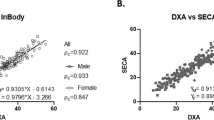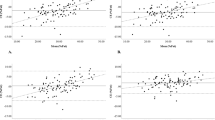Abstract
Background/Objectives:
The validity of bioelectrical impedance analysis (BIA) for body composition analysis is limited by assumptions relating to body shape. Improvement in BIA technology could overcome these limitations and reduce the population specificity of the BIA algorithm.
Subjects/Methods:
BIA equations for the prediction of fat-free mass (FFM), total body water (TBW) and extracellular water (ECW) were generated from data obtained on 124 Caucasians (body mass index 18.5–35 kg/m2) using a four-compartment model and dilution techniques as references. The algorithms were validated in an independent multiethnic population (n=130). The validity of BIA results was compared (i) between ethnic groups and (ii) with results from the four-compartment model and two-compartment methods (air-displacement plethysmography, dual-energy X-ray absorptiometry and deuterium dilution).
Results:
Indices were developed from segmental R and Xc values to represent the relative contribution of trunk and limbs to total body conductivity. The coefficient of determination for all prediction equations was high (R2: 0.94 for ECW, 0.98 for FFM and 0.98 for TBW) and root mean square error was low (1.9 kg for FFM, 0.8 l for ECW and 1.3 kg for TBW). The bias between BIA results and different reference methods was not statistically different between Afro-American, Hispanic, Asian or Caucasian populations and showed a similar difference (−0.2–0.2 kg FFM) when compared with the bias between different two-compartment reference methods (−0.2–0.3 kg FFM).
Conclusions:
An eight-electrode, segmental multifrequency BIA is a valid tool to estimate body composition in healthy euvolemic adults compared with the validity and precision of other two-compartment reference methods. Population specificity is of minor importance when compared with discrepancies between different reference methods.
This is a preview of subscription content, access via your institution
Access options
Subscribe to this journal
Receive 12 print issues and online access
$259.00 per year
only $21.58 per issue
Buy this article
- Purchase on Springer Link
- Instant access to full article PDF
Prices may be subject to local taxes which are calculated during checkout




Similar content being viewed by others
References
Müller MJ, Bosy-Westphal A, Krawczak M . Genetic studies of common types of obesity: a critique of the current use of phenotypes. Obes Rev 2010; 11: 612–618.
Walley AJ, Asher JE, Froguel P . The genetic contribution to non-syndromic human obesity. Nat Rev Genet 2009; 10: 431–442.
Buchholz AC, Bartok C, Schoeller DA . The validity of bioelectrical impedance models in clinical populations. Nutr Clin Pract 2004; 19: 433–446.
Baracos V, Caserotti P, Earthman CP, Fields D, Gallagher D, Hall KD et al. Advances in the science and application of body composition measurement. JPEN J Parenter Enteral Nutr 2012; 36: 96–107.
Dehghan M, Merchant AT . Is bioelectrical impedance accurate for use in large epidemiological studies? Nutr J 2008; 7: 26.
Organ LW, Bradham GB, Gore DT, Lozier SL . Segmental bioelectrical impedance analysis: theory and application of a new technique. J Appl Physiol 1994; 77: 98–112.
Fuller NJ, Jebb SA, Laskey MA, Coward WA, Elia M . Four-component model for the assessment of body composition in humans: comparison with alternative methods, and evaluation of the density and hydration of fat-free mass. Clin Sci (Lond) 1992; 82: 687–693.
Korth O, Bosy-Westphal A, Zschoche P, Gluer CC, Heller M, Muller MJ . Influence of methods used in body composition analysis on the prediction of resting energy expenditure. Eur J Clin Nutr 2007; 61: 582–589.
Siri W . Body composition from fluid spaces and density: analysis of methods. In: BJaH A (ed) Techniques for Measuring Body Composition. National Academy of Sciences: Washington DC, 1961, pp 223–244.
Pace N, Rathbun E . Studies on body composition. III. The body water and chemically combined nitrogen content in relation to fat content. J Biol Chem 1945; 158: 685–691.
Kehayias JJ, Ribeiro SM, Skahan A, Itzkowitz L, Dallal G, Rogers G et al. Water homeostasis, frailty and cognitive function in the nursing home. J Nutr Health Aging 2012; 16: 35–39.
Diouf A, Gartner A, Dossou NI, Sanon DA, Bluck L, Wright A et al. Validity of impedance-based predictions of total body water as measured by 2H dilution in African HIV/AIDS outpatients. Br J Nutr 2009; 101: 1369–1377.
Bland JM, Altman DG . Statistical methods for assessing agreement between two methods of clinical measurement. Lancet 1986; 1: 307–310.
Aleman-Mateo H, Rush E, Esparza-Romero J, Ferriolli E, Ramirez-Zea M, Bour A et al. Prediction of fat-free mass by bioelectrical impedance analysis in older adults from developing countries: a cross-validation study using the deuterium dilution method. J Nutr Health Aging 2010; 14: 418–426.
Dey DK, Bosaeus I, Lissner L, Steen B . Body composition estimated by bioelectrical impedance in the Swedish elderly. Development of population-based prediction equation and reference values of fat-free mass and body fat for 70- and 75-y olds. Eur J Clin Nutr 2003; 57: 909–916.
Sun SS, Chumlea WC, Heymsfield SB, Lukaski HC, Schoeller D, Friedl K et al. Development of bioelectrical impedance analysis prediction equations for body composition with the use of a multicomponent model for use in epidemiologic surveys. Am J Clin Nutr 2003; 77: 331–340.
Houtkooper LB, Lohman TG, Going SB, Howell WH . Why bioelectrical impedance analysis should be used for estimating adiposity. Am J Clin Nutr 1996; 64 (3 Suppl), 436S–448SS.
Piers LS, Soares MJ, Frandsen SL, O’Dea K . Indirect estimates of body composition are useful for groups but unreliable in individuals. Int J Obes Relat Metab Disord 2000; 24: 1145–1152.
Montagnese C, Williams JE, Haroun D, Siervo M, Fewtrell MS, Wells JC . Is a single bioelectrical impedance equation valid for children of wide ranges of age, pubertal status and nutritional status? Evidence from the 4-component model. Eur J Clin Nutr 2012; e-pub ahead of print 18 January 2012; doi:10.1038/ejcn.2011.213.
Foster KR, Lukaski HC . Whole-body impedance--what does it measure? Am J Clin Nutr 1996; 64 (3 Suppl), 388S–396SS.
Fuller NJ, Elia M . Potential use of bioelectrical impedance of the ‘whole body’ and of body segments for the assessment of body composition: comparison with densitometry and anthropometry. Eur J Clin Nutr 1989; 43: 779–791.
Wagner DR, Heyward VH . Measures of body composition in blacks and whites: a comparative review. Am J Clin Nutr 2000; 71: 1392–1402.
Shafer KJ, Siders WA, Johnson LK, Lukaski HC . Validity of segmental multiple-frequency bioelectrical impedance analysis to estimate body composition of adults across a range of body mass indexes. Nutrition 2009; 25: 25–32.
Acknowledgements
The research funding for this study was provided by seca Gmbh & Co. KG, Hamburg, Germany. The research in New York was also supported in part by National Institutes of Health Grant P30-DK26687. Publication of this article was supported by a grant from seca Gmbh & Co. KG, Hamburg, Germany.
Author information
Authors and Affiliations
Corresponding author
Ethics declarations
Competing interests
ABW and MJM serve as consultants for seca Gmbh & Co. KG, Hamburg, Germany. ABW has also received lecture fees from Medicom, seca and Unilever. DG has received lecture fees from seca. JJK serves as a consultant to Abbott Nutrition, Ohio, USA. JJK has also received grant support from Unilever and seca. The remaining authors declare no conflict of interest.
Rights and permissions
About this article
Cite this article
Bosy-Westphal, A., Schautz, B., Later, W. et al. What makes a BIA equation unique? Validity of eight-electrode multifrequency BIA to estimate body composition in a healthy adult population. Eur J Clin Nutr 67 (Suppl 1), S14–S21 (2013). https://doi.org/10.1038/ejcn.2012.160
Published:
Issue Date:
DOI: https://doi.org/10.1038/ejcn.2012.160
Keywords
This article is cited by
-
Effects of Specific Bioactive Collagen Peptides in Combination with Concurrent Training on Running Performance and Indicators of Endurance Capacity in Men: A Randomized Controlled Trial
Sports Medicine - Open (2023)
-
Association between body fat distribution and B-lymphocyte subsets in peripheral blood
Immunity & Ageing (2023)
-
Development and validation of bioelectrical impedance prediction equations estimating regional lean soft tissue mass in middle-aged adults
European Journal of Clinical Nutrition (2023)
-
Skeletal muscle estimation using magnetic-resonance-imaging-based equations for dual-energy X-ray absorptiometry and bioelectrical impedance analysis
European Journal of Clinical Nutrition (2023)
-
Impact of EASO/ESPEN-Defined Sarcopenic Obesity Following a Technology-Based Weight Loss Intervention
Calcified Tissue International (2023)



